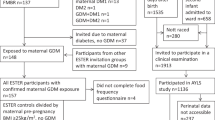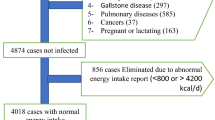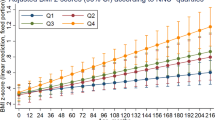Abstract
Background/objectives
We investigated if breastfeeding duration and current dietary patterns (DP) were associated with glucose and lipid metabolism biomarkers in women from the Nutritionist’s Health Study.
Subjects/methods
This is a cross-sectional analysis of 200 healthy undergraduates and nutrition graduates aged ≤45 years. Total [<6; ≥6 months] and predominant [<3; ≥3 months] breastfeeding were recalled using questionnaires. Diet were assessed using a food frequency questionnaire. DP obtained by factor analysis by principal component were categorized into tertiles of adherence (T1 = reference). Glucose and lipid biomarkers were categorized into tertiles (T1 + T2 = reference). Logistic regression was applied considering minimal sufficient adjustment recommended by directed acyclic graphs.
Results
Median (interquartile range) age and BMI were 23.0 (20.0; 28.5) years and 22.6 (20.7; 25.4) kg/m2, respectively. Mean ± SD values of glucose, LDL-c and HDL-c were 82.0 ± 9.0, 101.1 ± 29.6 and 54.4 ± 12.4 mg/dL, respectively. Women breastfed for <6 months had higher chance of being classified into T3 of insulin (OR = 2.87; 95%CI = 1.28–6.40). Predominant breastfeeding < 3 months was associated with insulin levels (OR = 2.27; 95%CI = 1.02–5.02) and HOMA-IR (OR = 2.36; 95%CI = 1.06−5.26). Breastfeeding was not associated with lipids. The Processed pattern was directly associated with LDL-c (T3: OR 6.08; 95%CI 1.80–20.58; P-trend = 0.004), while the Prudent pattern was inversely associated with LDL-c (T3: OR 0.26; 95%CI 0.08–0.87; P-trend = 0.029) and LDL-c/HDL-c ratio (T3: OR 0.28; 95%CI 0.08–0.97; P-trend = 0.046).
Conclusion
Early feeding could be a protective factor against insulin resistance development, while current DP were associated with lipid profile. This evidence indicates that from early life until early adulthood, dietary habits might influence women’s cardiometabolic risk profile.
This is a preview of subscription content, access via your institution
Access options
Subscribe to this journal
Receive 12 print issues and online access
$259.00 per year
only $21.58 per issue
Buy this article
- Purchase on Springer Link
- Instant access to full article PDF
Prices may be subject to local taxes which are calculated during checkout

Similar content being viewed by others
References
WHO. Global status report on noncommunicable diseases. Geneva: WHO Library Cataloguing-in-Publication Data; 2014.
Pirillo A, Bonacina F, Norata GD, Catapano AL. The interplay of lipids, lipoproteins, and immunity in atherosclerosis. Curr Atheroscler Rep. 2018;20:12.
Bonora E, Formentini G, Calcaterra F, Lombardi S, Marini F, Zenari L, et al. HOMA-estimated insulin resistance is an independent predictor of cardiovascular disease in type 2 diabetic subjects: prospective data from the verona diabetes complications study. Diabetes Care. 2002;25:1135–41.
Maas AH, van der Schouw YT, Regitz-Zagrosek V, Swahn E, Appelman YE, Pasterkamp G, et al. Red alert for women’s heart: the urgent need for more research and knowledge on cardiovascular disease in women: proceedings of the workshop held in Brussels on gender differences in cardiovascular disease, 29 September 2010. Eur Heart J. 2011;32:1362–8.
Olinto MT, Gigante DP, Horta B, Silveira V, Oliveira I, Willett W. Major dietary patterns and cardiovascular risk factors among young Brazilian adults. Eur J Nutr. 2012;51:281–91.
Pimenta AM, Toledo E, Rodriguez-Diez MC, Gea A, Lopez-Iracheta R, Shivappa N, et al. Dietary indexes, food patterns and incidence of metabolic syndrome in a Mediterranean cohort: The SUN project. Clin Nutr. 2015;34:508–14.
Xu SH, Qiao N, Huang JJ, Sun CM, Cui Y, Tian SS, et al. Gender differences in dietary patterns and their association with the prevalence of metabolic syndrome among Chinese: a cross-sectional study. Nutrients. 2016;8:180.
Lee J, Kim J. Association between dietary pattern and incidence of cholesterolemia in Korean Adults: the korean genome and epidemiology study. Nutrients 2018;10:1.
Nanri A, Mizoue T, Yoshida D, Takahashi R, Takayanagi R. Dietary patterns and A1C in Japanese men and women. Diabetes Care. 2008;31:1568–73.
Ruiz-Cabello P, Coll-Risco I, Acosta-Manzano P, Borges-Cosic M, Gallo-Vallejo FJ, Aranda P, et al. Influence of the degree of adherence to the Mediterranean diet on the cardiometabolic risk in peri and menopausal women. The Flamenco project. Nutr Metab Cardiovasc Dis. 2017;27:217–24.
AlEssa HB, Malik VS, Yuan C, Willett WC, Huang T, Hu FB, et al. Dietary patterns and cardiometabolic and endocrine plasma biomarkers in US women. Am J Clin Nutr. 2017;105:432–41.
Kang SH, Cho KH, Do JY. Association between the modified dietary approaches to stop hypertension and metabolic syndrome in postmenopausal women without diabetes. Metab Syndr Relat Disord. 2018;16:282–9.
Cho YA, Kim J, Cho ER, Shin A. Dietary patterns and the prevalence of metabolic syndrome in Korean women. Nutr Metab Cardiovasc Dis. 2011;21:893–900.
Mikkilä V, Räsänen L, Raitakari OT, Marniemi J, Pietinen P, Rönnemaa T, et al. Major dietary patterns and cardiovascular risk factors from childhood to adulthood. The Cardiovascular Risk in Young Finns Study. Br J Nutr. 2007;98:218–25.
Saneei P, Fallahi E, Barak F, Ghasemifard N, Keshteli AH, Yazdannik AR, et al. Adherence to the DASH diet and prevalence of the metabolic syndrome among Iranian women. Eur J Nutr 2015;54:421–8.
Wirfält E, Drake I, Wallström P. What do review papers conclude about food and dietary patterns? Food Nutr Res. 2013;57. https://doi.org/10.3402/fnr.v57i0.20523. (Published online).
Hu FB. Dietary pattern analysis: a new direction in nutritional epidemiology. Curr Opin Lipidol 2002;13:3–9.
Gluckman PD, Cutfield W, Hofman P, Hanson MA. The fetal, neonatal, and infant environments-the long-term consequences for disease risk. Early Hum Dev. 2005;81:51–9.
Ravelli AC, van der Meulen JH, Osmond C, Barker DJ, Bleker OP. Infant feeding and adult glucose tolerance, lipid profile, blood pressure, and obesity. Arch Dis Child. 2000;82:248–52.
Parikh NI, Hwang SJ, Ingelsson E, Benjamin EJ, Fox CS, Vasan RS, et al. Breastfeeding in infancy and adult cardiovascular disease risk factors. Am J Med. 2009;122:656–63.e1.
Fall CH, Borja JB, Osmond C, Richter L, Bhargava SK, Martorell R, et al. Infant-feeding patterns and cardiovascular risk factors in young adulthood: data from five cohorts in low- and middle-income countries. Int J Epidemiol. 2011;40:47–62.
Owen CG, Whincup PH, Cook DG. Breast-feeding and cardiovascular risk factors and outcomes in later life: evidence from epidemiological studies. Proc Nutr Soc. 2011;70:478–84.
Kelishadi R, Farajian S. The protective effects of breastfeeding on chronic non-communicable diseases in adulthood: a review of evidence. Adv Biomed Res. 2014;3:3.
Pirilä S, Taskinen M, Viljakainen H, Mäkitie O, Kajosaari M, Saarinen-Pihkala UM, et al. Breast-fed infants and their later cardiovascular health: a prospective study from birth to age 32 years. Br J Nutr. 2014;111:1069–76.
Horta BL, Loret de Mola C, Victora CG. Long-term consequences of breastfeeding on cholesterol, obesity, systolic blood pressure and type 2 diabetes: a systematic review and meta-analysis. Acta Paediatr. 2015;104:30–7.
Owen CG, Whincup PH, Kaye SJ, Martin RM, Davey Smith G, Cook DG, et al. Does initial breastfeeding lead to lower blood cholesterol in adult life? A quantitative review of the evidence. Am J Clin Nutr. 2008;88:305–14.
Hayosh O, Mandel D, Mimouni FB, Lahat S, Marom R, Lubetzky R. Prolonged duration of breastfeeding does not affect lipid profile in adulthood. Breastfeed Med. 2015;10:218–21.
Owen CG, Martin RM, Whincup PH, Smith GD, Cook DG. Does breastfeeding influence risk of type 2 diabetes in later life? A quantitative analysis of published evidence. Am J Clin Nutr. 2006;84:1043–54.
Al Mamun A, O’Callaghan MJ, Williams GM, Najman JM, Callaway L, McIntyre HD. Breastfeeding is protective to diabetes risk in young adults: a longitudinal study. Acta Diabetol 2015;52:837–44.
Folchetti LG, Silva IT, Almeida-Pititto B, Ferreira SR. Nutritionists’ Health Study cohort: a web-based approach of life events, habits and health outcomes. BMJ Open. 2016;6:e012081.
Craig CL, Marshall AL, Sjöström M, Bauman AE, Booth ML, Ainsworth BE, et al. International physical activity questionnaire: 12-country reliability and validity. Med Sci Sports Exerc. 2003;35:1381–95.
Matsudo S, Araújo T, Matsudo V, Andrade D, Andrade E, Oliveira L, et al. Questionario Internacional de Atividade Física (IPAQ): estudo de validade e reprodutibilidade no Brasil. Ativ Fis e Saúde 2001;6:5–18.
Selem SS, Carvalho AM, Verly-Junior E, Carlos JV, Teixeira JA, Marchioni DM, et al. Validity and reproducibility of a food frequency questionnaire for adults of São Paulo, Brazil. Rev Bras. Epidemiol 2014;17:852–9.
USDA. National Nutrient Database for Standard Reference, Release 28 (online). Basic Report, Nutrient data for 11114, Cabbage, savoy, raw. United States Department of Agriculture, Agricultural Research Service; 2016.
Eshriqui I, Folchetti LD, Valente AMM, de Almeida-Pititto B, Ferreira SRG. Breastfeeding duration is associated with offspring’s adherence to prudent dietary pattern in adulthood: results from the Nutritionist’s Health Study. J Dev Orig Health Dis. 2019:1–10. https://doi.org/10.1017/S204017441900031X. (Published online).
Matthews DR, Hosker JP, Rudenski AS, Naylor BA, Treacher DF, Turner RC. Homeostasis model assessment: insulin resistance and beta-cell function from fasting plasma glucose and insulin concentrations in man. Diabetologia 1985;28:412–9.
Friedewald WT, Levy RI, Fredrickson DS. Estimation of the concentration of low-density lipoprotein cholesterol in plasma, without use of the preparative ultracentrifuge. Clin Chem. 1972;18:499–502.
Textor J, Hardt J, Knüppel S. DAGitty: a graphical tool for analyzing causal diagrams. Epidemiology 2011;22:745.
Hui LL, Kwok MK, Nelson EAS, Lee SL, Leung GM, Schooling CM. The association of breastfeeding with insulin resistance at 17 years: Prospective observations from Hong Kong’s “Children of 1997” birth cohort. Matern Child Nutr. 2018;14:e12490. https://doi.org/10.1111/mcn.12490. (Published online).
Singhal A, Lucas A. Early origins of cardiovascular disease: is there a unifying hypothesis? Lancet 2004;363:1642–5.
Wang X, Xing KH, Qi J, Guan Y, Zhang J. Analysis of the relationship of insulin-like growth factor-1 to the growth velocity and feeding of healthy infants. Growth Horm IGF Res. 2013;23:215–9.
Savino F, Liguori SA, Sorrenti M, Fissore MF, Oggero R. Breast milk hormones and regulation of glucose homeostasis. Int J Pediatr. 2011;2011:803985.
Robinson S, Ntani G, Simmonds S, Syddall H, Dennison E, Sayer AA, et al. Type of milk feeding in infancy and health behaviours in adult life: findings from the Hertfordshire Cohort Study. Br J Nutr. 2013;109:1114–22.
Choi JH, Woo HD, Lee JH, Kim J. Dietary patterns and risk for metabolic syndrome in korean women: a cross-sectional study. Med (Baltim). 2015;94:e1424.
Paliy O, Piyathilake CJ, Kozyrskyj A, Celep G, Marotta F, Rastmanesh R. Excess body weight during pregnancy and offspring obesity: potential mechanisms. Nutrition. 2014;30:245–51.
Tan HC, Roberts J, Catov J, Krishnamurthy R, Shypailo R, Bacha F. Mother’s pre-pregnancy BMI is an important determinant of adverse cardiometabolic risk in childhood. Pediatr Diabetes. 2015;16:419–26.
Siervo M, Lara J, Chowdhury S, Ashor A, Oggioni C, Mathers JC. Effects of the dietary approach to stop hypertension (DASH) diet on cardiovascular risk factors: a systematic review and meta-analysis. Br J Nutr. 2015;113:1–15.
Anderson JW, Hanna TJ. Impact of nondigestible carbohydrates on serum lipoproteins and risk for cardiovascular disease. J Nutr. 1999;129 Suppl 7:1457S–66S.
Gershuni VM. Saturated fat: part of a healthy diet. Curr Nutr Rep. 2018;7:85–96.
Natland ST, Andersen LF, Nilsen TI, Forsmo S, Jacobsen GW. Maternal recall of breastfeeding duration twenty years after delivery. BMC Med Res Methodol. 2012;12:179.
Acknowledgements
We thank NutriHS research team and participants, who were committed to collect and provide, respectively, good quality data.
Funding
This work was supported by the São Paulo Foundation for Research Support—FAPESP, Brazil, which played no role in the study design; data collection; analysis or interpretation of data; or in drafting the manuscript.
Author information
Authors and Affiliations
Contributions
Conception and design of the study: SRGF and BAP. Collection of data: LDF, BAP, AMMV, IE, and SRGF. Data analysis and interpretation: IE and SRGF. Drafting of the manuscript: IE and SRGF. Revision of the manuscript: IE, SRGF, BAP, AMMV and LDF. Approval of the final version of the manuscript: IE, SRGF, BAP, AMMV and LDF.
Corresponding author
Ethics declarations
Conflict of interest
The authors declare that they have no conflict of interest.
Additional information
Publisher’s note Springer Nature remains neutral with regard to jurisdictional claims in published maps and institutional affiliations.
Supplementary information
41430_2019_516_MOESM1_ESM.docx
Suplementary Figure 1. Directed Acyclic Graph (DAG) for the association between breastfeeding and glucose and lipid metabolism biomarkers
41430_2019_516_MOESM2_ESM.docx
Suplementary Figure 2. Directed Acyclic Graph (DAG) for the association between dietary patterns and glucose and lipid metabolism biomarkers
Rights and permissions
About this article
Cite this article
Eshriqui, I., Folchetti, L.D., Valente, A.M.M. et al. Early life feeding and current dietary patterns are associated with biomarkers of glucose and lipid metabolism in young women from the Nutritionist’s Health Study. Eur J Clin Nutr 74, 509–517 (2020). https://doi.org/10.1038/s41430-019-0516-8
Received:
Revised:
Accepted:
Published:
Issue Date:
DOI: https://doi.org/10.1038/s41430-019-0516-8
This article is cited by
-
Determinants of obesity in Latin America
Nature Metabolism (2024)



